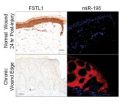(Press-News.org) A multi-institutional study has revealed that BRAF-positive metastatic malignant melanomas develop resistance to treatment with drugs targeting the BRAF/MEK growth pathway through a major change in metabolism. The findings, which will be published in Cancer Cell and have been released online, suggest a strategy to improve the effectiveness of currently available targeted therapies.
"We were surprised to find that melanoma cells treated with the BRAF inhibitor vemurafenib dramatically change the way they produce energy to stay alive," says David E. Fisher, MD, PhD, chief of Dermatology at Massachusetts General Hospital (MGH) and a co-corresponding author of the Cancer Cell paper. "While current BRAF inhibitor treatment is a major improvement – shrinking tumors in most patients and extending survival for several months – patients eventually relapse. So there is an ongoing need to improve both the magnitude and durability of these responses."
In about half the cases of malignant melanoma – the most deadly form of skin cancer – tumor growth is driven by mutations in the BRAF gene. Research by investigators at the MGH Cancer Center and elsewhere has shown that treatment with drugs that block BRAF activity temporarily halts tumor growth. Combining a BRAF inhibitor with a drug that targets MEK, another protein in the same growth pathway, strengthens and extends the antitumor response. The current study was designed to investigate how BRAF inhibition changes metabolic activity within melanoma cells and to find other possible treatment targets.
The most common way that cells convert glucose into energy is called oxidative phosphorylation and largely relies on the activity of the cellular structures called mitochondria. Many cancer cells use an alternative mechanism that produces the energy compound ATP without involving mitochondria. A series of experiments by the MGH team revealed that the elevated BRAF activity in BRAF-positive melanoma cells suppresses oxidative phosphorylation by reducing expression of a transcription factor called MITF. Suppressing production of MITF reduced levels of a protein called PGC1α that regulates the generation and function of mitochondria. But melanoma cells treated with a BRAF inhibitor showed elevated MITF activity, along with increased expression of oxidative phosphorylation genes and greater numbers of mitochondria. By switching to oxidative phosphorylation to supply the energy they need, the tumor cells increased their ability to survive in spite of BRAF inhibitor treatment.
"These findings suggest that combination treatment with mitochondrial inhibitors could improve the efficacy of BRAF inhibitors in malignant melanoma," says Fisher, the Wigglesworth Professor of Dermatology at Harvard Medical School. "Several small molecules that target mitochondrial metabolism have been identified by investigators here at the MGH and elsewhere, and laboratory investigations of specific combinations of BRAF inhibitors with mitochondrial antagonists are currently underway."
###
Rizwan Haq, MD, of the MGH Cancer Center and Department of Dermatology, is lead author of the Cancer Cell paper, and co-corresponding authors are Zolt Arany, MD, Beth Israel Deaconess Medical Center, and Hans Widlund, PhD, Brigham and Women's Hospital. Support for the study includes grant R01AR043369-16 from the National Institute of Arthritis and Musculoskeletal and Skin Diseases, National Cancer Institute grants R01CA163336 and P50CA093683, and grants from the Melanoma Research Alliance and the Dr. Miriam and Sheldon G. Adelson Medical Research Foundation.
Massachusetts General Hospital (http://www.massgeneral.org), founded in 1811, is the original and largest teaching hospital of Harvard Medical School. The MGH conducts the largest hospital-based research program in the United States, with an annual research budget of more than $775 million and major research centers in AIDS, cardiovascular research, cancer, computational and integrative biology, cutaneous biology, human genetics, medical imaging, neurodegenerative disorders, regenerative medicine, reproductive biology, systems biology, transplantation biology and photomedicine. In July 2012, MGH moved into the number one spot on the 2012-13 U.S. News & World Report list of "America's Best Hospitals." END
BRAF inhibitor treatment causes melanoma cells to shift how they produce energy
Identifying mechanism behind treatment resistance suggests possible strategy for improvement
2013-03-08
ELSE PRESS RELEASES FROM THIS DATE:
A*STAR scientists discover 'switch' critical to wound healing
2013-03-08
Patients with diseases such as diabetes suffer from painful wounds that take a long time to heal making them more susceptible to infections that could even lead to amputations. A*STAR's discovery paves the way for therapeutics to improve healing of such chronic wounds, which are a significant burden to patients.
1. Scientists from A*STAR's Institute of Medical Biology (IMB) have identified a molecular "switch" that controls the migration of skin cells necessary for wounds to close and heal. This is especially significant for diabetics and other patients who suffer from ...
Stanford scientists calculate the carbon footprint of grid-scale battery technologies
2013-03-08
Americans take electrical power for granted whenever they flip on a light switch. But the growing use of solar and wind power in the United States makes the on-demand delivery of electricity more challenging.
A key problem is that the U.S. electrical grid has virtually no storage capacity, so grid operators can't stockpile surplus clean energy and deliver it at night, or when the wind isn't blowing.
To provide more flexibility in managing the grid, researchers have begun developing new batteries and other large-scale storage devices. But the fossil fuel required to ...
Home toxic home
2013-03-08
EAST LANSING, Mich. — Most organisms would die in the volcanic sulfur pools of Yellowstone and Mount Etna. Robust simple algae call it home, and their secrets to survival could advance human medicine and bioremediation.
Mike Garavito, Michigan State University professor of biochemistry and molecular biology was part of a research team that revealed how primitive red algae use horizontal gene transfer, in essence stealing useful genes from other organisms to evolve and thrive in harsh environments.
Their study, published in the current issue of Science, shows that the ...
Anti-aging drug breakthrough
2013-03-08
Drugs that combat ageing may be available within five years, following landmark work led by an Australian researcher.
The work, published in the March 8 issue of Science, finally proves that a single anti-ageing enzyme in the body can be targeted, with the potential to prevent age-related diseases and extend lifespans.
The paper shows all of the 117 drugs tested work on the single enzyme through a common mechanism. This means that a whole new class of anti-ageing drugs is now viable, which could ultimately prevent cancer, Alzheimer's disease and type 2 diabetes.
"Ultimately, ...
Virus and genes involved in causation of schizophrenia
2013-03-08
Viruses and genes interact in a way that may increase the risk of developing schizophrenia significantly. This happens already in the developing foetus.
An international team of scientists led by Aarhus University, Denmark, has made this discovery. As the first in the world, they scanned the entire genome of hundreds of sick and healthy people to see if there is an interaction between genes and a very common virus - cytomegalovirus - and to see whether the interaction influences the risk of developing schizophrenia.
And it does.
Women that have been infected by the virus ...
Specialised germanium surface as universal protein adapter
2013-03-08
Researchers at the Ruhr Universität Bochum have developed a new method for attaching proteins to the surface of germanium crystals – for the first time also membrane proteins. This enables time-resolved tracking of the interactions between molecules using infrared spectroscopy in a way that is accurate down to atomic resolution. The method is applied in the EU project "Kinetics for Drug Discovery, K4DD", in which scientists explore the interplay of drugs and their interaction partners. With the new technology, the researchers can also study so-called G-protein-coupled receptors, ...
Maternal obesity increases the risk of frequent wheezing in offspring
2013-03-08
The fact that excess weight during pregnancy has negative consequences is not new information. A new study now concludes that the children of mothers obese before falling pregnant are four times more likely to have frequent wheezing, which is one of the symptoms of asthma, compared to the children of mothers weighing a normal weight.
Researchers from the Centre for Research in Environmental Epidemiology (CREAL) assessed whether obesity in mothers increases the risk of their children having frequent wheezing, a symptom associated with susceptibility to asthma during infancy ...
Signaling molecule may help stem cells focus on making bone despite age, disease
2013-03-08
AUGUSTA, Ga. – A signaling molecule that helps stem cells survive in the naturally low-oxygen environment inside the bone marrow may hold clues to helping the cells survive when the going gets worse with age and disease, researchers report.
They hope the findings, reported in PLOS ONE, will result in better therapies to prevent bone loss in aging and enhance success of stem cell transplants for a wide variety of conditions from heart disease to cerebral palsy and cancer.
They've found that inside the usual, oxygen-poor niche of mesenchymal stem cells, stromal cell-derived ...
Scientists discuss relationship between abortion and violence against women
2013-03-08
This press release is available in Spanish.
New York, March 8th 2013 – Scientists of the United States of America, Ireland, and Chile met this week in New York to discuss recent scientific evidence regarding abortion as a form of growing violence against women and girls. Indiscriminate practice of abortion is significantly correlated with coercion, a history of sexual abuse, violence during pregnancy, intimate partner violence, and with psychological consequences that may lead to suicide.
The scientific evidence was discussed by Doctors Monique Chireau (North Carolina, ...
Wayne State researcher gives new name to exhaustion suffered by cancer patients
2013-03-08
DETROIT — The fatigue experienced by patients undergoing cancer treatments has long been recognized by health care providers, although its causes and ways to manage it are still largely unknown.
A Wayne State University researcher believes the condition affects some patients much more than others and is trying to determine the nature of that difference.
Horng-Shiuann Wu, Ph.D., assistant professor of nursing in the College of Nursing, has made an effort to chronicle the parameters of what she calls sudden exhaustion syndrome. Her study, "Definition, Prevalence and Characteristics ...
LAST 30 PRESS RELEASES:
Tracing the quick synthesis of an industrially important catalyst
New software sheds light on cancer’s hidden genetic networks
UT Health San Antonio awarded $3 million in CPRIT grants to bolster cancer research and prevention efforts in South Texas
Third symposium spotlights global challenge of new contaminants in China’s fight against pollution
From straw to soil harmony: International team reveals how biochar supercharges carbon-smart farming
Myeloma: How AI is redrawing the map of cancer care
Manhattan E. Charurat, Ph.D., MHS invested as the Homer and Martha Gudelsky Distinguished Professor in Medicine at the University of Maryland School of Medicine
Insilico Medicine’s Pharma.AI Q4 Winter Launch Recap: Revolutionizing drug discovery with cutting-edge AI innovations, accelerating the path to pharmaceutical superintelligence
Nanoplastics have diet-dependent impacts on digestive system health
Brain neuron death occurs throughout life and increases with age, a natural human protein drug may halt neuron death in Alzheimer’s disease
SPIE and CLP announce the recipients of the 2025 Advanced Photonics Young Innovator Award
Lessons from the Caldor Fire’s Christmas Valley ‘Miracle’
Ant societies rose by trading individual protection for collective power
Research reveals how ancient viral DNA shapes early embryonic development
A molecular gatekeeper that controls protein synthesis
New ‘cloaking device’ concept to shield sensitive tech from magnetic fields
Researchers show impact of mountain building and climate change on alpine biodiversity
Study models the transition from Neanderthals to modern humans in Europe
University of Phoenix College of Doctoral Studies releases white paper on AI-driven skilling to reduce burnout and restore worker autonomy
AIs fail at the game of visual “telephone”
The levers for a sustainable food system
Potential changes in US homelessness by ending federal support for housing first programs
Vulnerability of large language models to prompt injection when providing medical advice
Researchers develop new system for high-energy-density, long-life, multi-electron transfer bromine-based flow batteries
Ending federal support for housing first programs could increase U.S. homelessness by 5% in one year, new JAMA study finds
New research uncovers molecular ‘safety switch’ shielding cancers from immune attack
Bacteria resisting viral infection can still sink carbon to ocean floor
Younger biological age may increase depression risk in older women during COVID-19
Bharat Innovates 2026 National Basecamp Showcases India’s Most Promising Deep-Tech Ventures
Here’s what determines whether your income level rises or falls
[Press-News.org] BRAF inhibitor treatment causes melanoma cells to shift how they produce energyIdentifying mechanism behind treatment resistance suggests possible strategy for improvement




